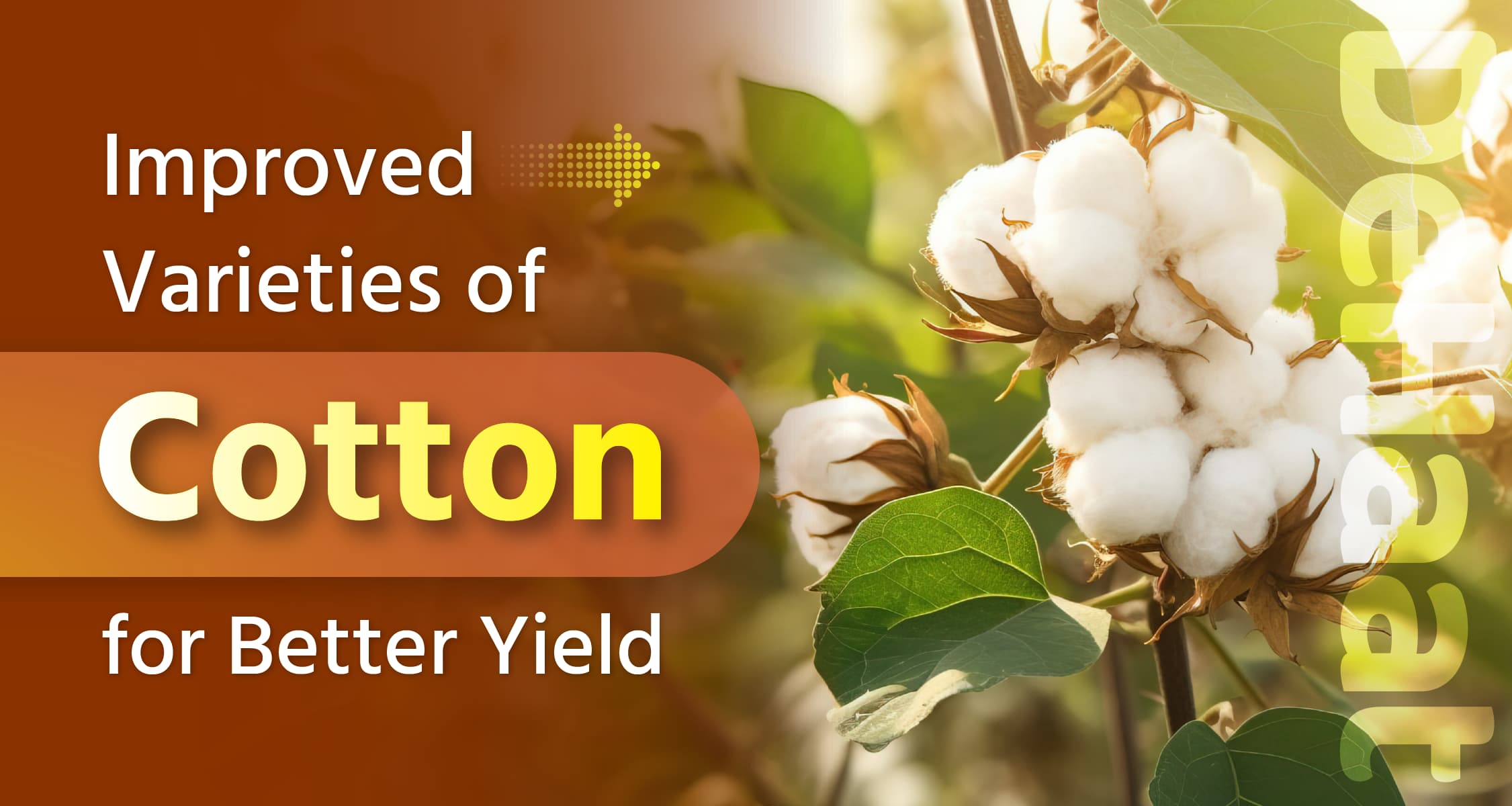Improved Varieties of Cotton for Better Yield

The varieties of cotton are divided into three types. These include cotton with short fibers, medium fibers, and long fibers. Cotton with long fibers is considered the best variety. Their length is about 5 cm. Approximately 40% of the total cotton production consists of cotton with long fibers. On the other hand, cotton with medium fibers, ranging from 3.5 to 5 cm in length, constitutes about 45% of the total cotton production. As for cotton with short fibers, only 15% of the total cotton production falls into this category. The length of the fibers of cotton in this category is less than 3.5 cm. Here, in this blog, we will cover information about the improved varieties of cotton that can help you get good quality cotton.
DeHaat Varieties for Better Yield of Cotton
- DeHaat DCS 1102: This variety is suitable for cultivation in Maharashtra, Madhya Pradesh, and Gujarat. The balls of this variety are large and heavier in size. The bolls open well and cleanly, making it easy to pick cotton. This variety produces more cotton bolls per plant, resulting in increased yield. Proper and well-managed cultivation in black soil can generate a good yield. This variety is tolerant to sucking pests.
- DeHaat Maxcot: It takes about 140-145 days for this variety to mature. The plants of this variety are tall, and each cotton boll weighs around 5.5-6 gm. The bolls of cotton are large and they open well, making it easy to pick cotton. The plants of this variety are resistant to sucking pests.
Other Improved Varieties of Cotton Seeds
- Rasi 659: This variety is suitable for cultivation in medium-heavy soil. It takes about 145-160 days for the crop to mature. The bolls that grow on this variety are large in size, resulting in the attainment of heavier cotton. The bolls are clean and open well, making cotton-picking easier.
- Kaveri Atm: This is a medium-duration variety. It may take 150-170 days for this variety to mature. The plants of this variety are erect, and they bear a higher number of bolls per plant. The bolls produced by this variety are larger in size, with each boll weighing between 4.5 to 6.5 gm. The internode distance is reduced in these plants, and this variety is resistant to bollworms and CLCuV (Cotton Leaf Curl Virus).
- Mahyco Jungee: This is one of the quickly maturing varieties. The crop is ready in about 150-160 days. The distance between the bolls on these plants is lesser.
- Ajeet 155: This variety can be cultivated on medium-light soil. It is a medium-duration crop. The crop is ready for harvest in about 140-150 days after sowing. The bolls formed on the plants are of medium size. This variety is tolerant to sucking pests. The plants of this variety are also tolerant to drought conditions. Therefore, this cultivation can be done in areas with water scarcity or inadequate irrigation facilities.
- Seed Pro 8694: It takes about 160-170 days for this variety of crops to mature. The plants of this variety are tall and strong, reducing the chances of falling. The leaves of the plants are of velvety texture. The likelihood of an outbreak of sucking pests is reduced in the plants of this variety. It is easy to pick cotton from the plants of this variety.
- Rasi Super 773: This is a medium-duration crop with early maturity. It takes about 140-150 days for the crop to mature. The plants are taller in height. This variety is resistant to sucking pests.
- Crystal 7007: This variety matures quickly in a medium duration. It takes about 170-175 days for the crop to mature. The cotton bolls of this variety are medium-sized and round. This variety is tolerant to early sucking pests.
- Mahyco Balraj: It takes 160-170 days for this variety of crops to mature. The cotton bolls that develop on the plants of this variety are larger in size. They also weigh more. The picking of the cotton bolls is easy in this variety.
Which variety of cotton seeds do you use in farming, and how much yield do you obtain from it? Please share your response and experience with us in the comments. For more agricultural-related information, you can also contact DeHaat's agri-experts through our toll-free number 1800-1036-110. Also, don't forget to like and share this post. For more such information, follow the 'Krishi Gyan' channel now.
Frequently Asked Questions (FAQs)
Q: In which months is cotton sown?
A: Cotton is usually sown during the Kharif season in India, which is during the months of May and June. However, the right time for sowing may vary depending on the region and weather conditions. In some areas, sowing can also be done in April.
Q: What fertilizer should be used in cotton farming?
A: To ensure better growth of cotton, it is necessary to use fertilizers in balanced quantities. For the proper development of the crop, urea, diammonium phosphate (DAP), muriate of potash (MOP), along single superphosphate (SSP) fertilizers should be used.
Q: What factors should be considered before the sowing of cotton seeds?
A: Several things need to be considered before sowing cotton, including soil preparation, seed selection, seed quantity, seed depth, use of fertilizers, etc.
जारी रखने के लिए कृपया लॉगिन करें

फसल चिकित्सक से मुफ़्त सलाह पाएँ
